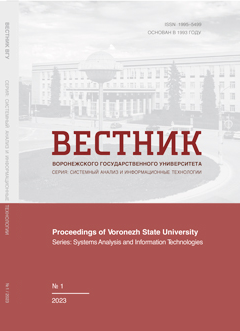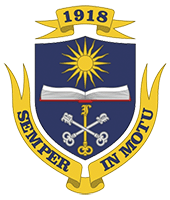Решение задачи классификации объектов на изображении методами компьютерного зрения в различных сферах человеческой деятельности
Аннотация
В данной обзорной статье представлен анализ основных направлений исследований по теме классификация объектов на изображении методами компьютерного зрения. Методы компьютерного зрения позволяют автоматизировать процесс выделения семантического смысла из изображений. Под классификацией объектов на изображении понимается локализация объектов, интересующих исследователя, и соотнесение их с определенным классом. Актуальность данной темы закреплена в государственной программе: национальная стратегия развития искусственного интеллекта на период до 2030 года. Так же в статье приведена статистика публикационной активности научных авторов по теме «компьютерное зрение», которая показывает актуальность данного направления. Работа имеет следующую структуру: во введении статьи приведены различные статистики, отражающие актуальность темы. Далее приведен обзор научных исследований посвященных решению прикладных аспектов задачи классификации объектов на изображении в различных областях человеческой деятельности. Основной упор сделан на следующие прикладные области: медицина, промышленность, безопасность, транспорт и военное дело. Далее приведен анализ методов, которые используются для решения задачи классификации объектов на изображении. Автор выделяет две группы методов: классические и нейросетевые методы. Под классическими алгоритмами и методами понимается подход к решению задачи классификации объектов на изображении, в котором не используются искусственные нейронные сети. Выводы. Тема исследования на сегодня является актуальной, что подтверждено статистикой и государственными программами. Для классических методов выявлены следующие недостатки: для каждой новой прикладной задачи требуется построение алгоритма ее решения, трудоемкость выделения значимых признаков и неустойчивость при работе с определенными видами данных. Для нейросетевых методов основным недостатком является зависимость конечной модели от качества набора данных, на котором она обучается.
Скачивания
Литература
2. Lon Ling [et al.] (2021) MRI-based traditional radiomics and computer-vision nomogram for predicting lymphovascular space invasion in endometrial carcinoma. Diagnostic and Interventional Imaging. 102.7-8. P. 455–462.
3. Chandrasekaran Anita C. [et al.] (2021) Computer vision applied to dual-energy computed tomography images for precise calcinosis cutis quantification in patients with systemic sclerosis. Arthritis Research & Therapy. 23.1. P. 1–9. DOI
4. Haq Inayatul [et al.] (2022) Machine Vision Approach for Diagnosing Tuberculosis (TB) Based on Computerized Tomography (CT) Scan Images. Symmetry. 14.10. 1997. DOI
5. Tanaeva E. G. (2020) Methods and algorithms for morphological assessment of diagnostically significant objects on fundus images: abstract of thesis. Ph.D. tech. Sci. Yoshkar-Ola : PSTU. 19 p.
6. Shirokanev A. S. (2021) Computer system for processing and analyzing fundus data to support laser coagulation in the treatment of diabetic retinopathy: abstract of thesis. Ph.D. tech. Sci. St. Petersburg. 20 p.
7. Xu Baoguo [et al.] (2022) Continuous hybrid bci control for robotic arm using noninvasive electroencephalogram, computer vision, and eye tracking. Mathematics 10.4. 618. DOI
8. Huang Xiaohuan [et al.] (2016) Multi-modal emotion analysis from facial expressions and electroencephalogram. Computer Vision and Image Understanding. 147. P. 114–124. DOI
9. Tanaka Hiroki [et al.] (2019) Computer-aided diagnosis system for breast ultrasound images using deep learning. Physics in Medicine & Biology 64.23. 235013. DOI
10. Cheng Phillip M. and Harshawn S. Malhi (2017) Transfer learning with convolutional neural networks for classification of abdominal ultrasound images. Journal of digital imaging. 30. P. 234–243. DOI
11. Shelomentseva I. G. (2022) Models and algorithms for segmentation and recognition of objects on medical images of light microscopy of low spatial resolution: abstract of thesis. Ph.D. tech. Sci. Krasnoyarsk. 20 p.
12. Karpov A. A. and Ronzhin A. L. (2015) Multimodal interfaces for human interaction with computers and robots. Current problems of labor psychology, engineering psychology and ergonomics. Issue 7. Ed. A. A. Oboznova, A. L. Zhuravleva. Publishing house «Institute of Psychology RAS». P. 441–460.
13. Spirkin A. N. (2020) Bionic methods of controlling a robotic mechanism. Measurement. Monitoring. Control. Control. No 4 (34). P. 84–90. DOI
14. Sotnikov P. I. (2020) Development of methods and algorithms for the classification of multi-dimensional time series in the brain-computer interface: abstract of thesis. dis. Ph.D. Moscow. 18 p.
15. Fei Zixiang [et al.] (2020) Deep convolution network based emotion analysis towards mental health care. Neurocomputing, 388. P. 212–227. DOI
16. Sulistiani H. [et al] (2021) J. Phys.: Conf. Ser. 1751 012040 DOI
17. Bargshady Ghazal [et al.] (2020) Enhanced deep learning algorithm development to detect pain intensity from facial expression images. Expert Systems with Applications. 149. 113305. DOI
18. Ngoc Anh B., Tung Son N., Truong Lam P., Phuong Chi L., Huu Tuan N., Cong Dat N., Huu Trung N., Umar Aftab M., Van Dinh T. (2019) A Computer-Vision Based Application for Student Behavior Monitoring in Classroom. Applied Sciences. 9(22). 4729. DOI
19. Bouhlal Meriem [et al.] (2020) Emotions recognition as innovative tool for improving students’ performance and learning approaches. Procedia Computer Science. 175. P. 597–602. DOI
20. Usilin S. A. (2017) Algorithmic development of Viola-Jones detectors for solving applied problems of image recognition: abstract of thesis. dis. Ph.D. Moscow. 22 p.
21. Nyan Win Htet (2020) Information system for quality control of the production of multilayer woven materials based on processing their images: abstract of thesis. Ph.D. tech. Sci. Moscow : “MIET”. 28 p.
22. Kofnov O. V. (2016) Model and algorithms for digital image processing for estimating the geometric parameters of materials with a periodic structure: abstract of thesis. Ph.D. tech. Sci. St. Petersburg: “SPbGUPTD”, 18 p.
23. Malysheva A. V. (2020) Models and algorithms for decision support in managing the flotation process of potassium ore: abstract of thesis. Ph.D. tech. Sci. Nizhny Novgorod. 24 p.
24. Ostapov D. S. (2018) Identification with a detailed assessment of the state of objects and their mass quantity by computer vision systems: abstract of thesis. Ph.D. tech. Sci. Krasnodar : “KubSTU”. 24 p.
25. Posokhov I. A. (2017) Method and algorithms for processing images of sulfur prints in a system for assessing the quality of continuous castings: abstract of thesis. Ph.D. tech. Sci. Cherepovets. 20 p.
26. Donskikh A. O. (2020) Models and algorithms for information processing in systems for express analysis and classification of a heterogeneous flow of objects using spectral measurements: abstract of thesis. Ph.D. tech. Sci. Voronezh : “VSU”. 21 p.
27. Shkaberina G. Sh. (2020) Models and algorithms for automatic product classification: abstract of thesis. Ph.D. tech. Sci. Krasnoyarsk. 21 p.
28. Terekhin A. V. (2015) Algorithms for determining dimensionless features of images of projections of three-dimensional objects and their recognition: abstract of thesis. Ph.D. tech. Sci. “Vladimir State University named after Alexander Grigorievich and Nikolai Grigorievich Stoletov”. 20 p.
29. Astafiev A. V. (2015) Methods and algorithms for localizing images of industrial product markings based on recurrent search for the averaged maximum: abstract of thesis. Ph.D. tech. Sci. “Vladimir State University named after Alexander Grigorievich and Nikolai Grigorievich Stoletov”. 20 p.
30. Ilyina E. S. (2018) Development of a method for marking objects and an algorithm for its recognition in conditions of significant distortions: abstract of thesis. Ph.D. tech. Sci. St. Petersburg: ITMO. 28 p.
31. Mohammed Mamdouh Mohammed Gomaa (2017) Face detection algorithms based on image analysis and processing: abstract of thesis. Ph.D. tech. Sci. Belgorod. 20 p.
32. Khurshudov A. A. (2015) Development of a visual image recognition system in a data stream: abstract of thesis. Ph.D. tech. Sci. Krasnodar: “KubTGU”. 24 p.
33. Wai Yang Ming (2021) Research and development of facial recognition algorithms for automated checkpoints: abstract of thesis. Ph.D. tech. Sci. Moscow : “MIET”. 22 p.
34. Zhiganov S. V. (2019) Computational method and algorithms for neuro-fuzzy recognition of people, vehicles and situations based on video surveillance: abstract... dis. Ph.D. tech. Sci. Komsomolsk-on-Amur: “KnAGU”. 19 p.
35. Druki A. A. (2015) Algorithms for neural network detection and recognition of characters on a complex background: abstract of thesis. dis. Ph.D. Tomsk. 23 p.
36. Kolosovsky M. A. (2015) Model-algorithmic support for an intelligent video surveillance system for unregulated pedestrian crossings: abstract of thesis. dis. Ph.D. Novosibirsk. 22 p.
37. Abramov M. V., Yeltsov D. A. (2023) Neural networks with LSTM and GRU in application to the task of multiclass classification of text posts of social network users. Proceedings of Voronezh state university. Series: systems analysis and information technologies. 3. P. 95–106. DOI
38. Kostyukevich T. A., Liberman A. I. (2023) Decision support program for identifying vehicles at a checkpoint by state license plate: Certificate of registration of the computer program RU 2023683647, 09.11.2023. Application dated 07.14.2023.
39. Zakharkin G. F. (2021) Development of special mathematical and software for security alarm systems with a screw magnetometric transducer: abstract of thesis. dis. Ph.D. Yekaterinburg: “Ural Federal University named after the first President of Russia B.N. Yeltsin”. 22 p.
40. Cherkasova V. A., Dyudneva L. R. and Petrova A. S. (2016) Protection from terrorist threats in railway transport. Scientific, technical and economic cooperation of Asia-Pacific countries in the 21st century. T. 1. P. 218–221.
41. Perumalraja r. (2022) Real-Time Dangerous Marine Animals Monitoring to Alert Scuba Divers Using Computer Vision. Periodico di mineralogia. No 4. P.1460–1470.
42. Thet Naing Vin (2018) Access control and management systems using algorithms for spatio-temporal image analysis: abstract of thesis. dis. Ph.D. M. 28 p.
43. Pham Duy Thai (2015) Mathematical support for the fingerprint identification system, taking into account the peculiarities of their use in Vietnam: abstract of thesis. dis. Ph.D. Moscow “MIREA”. 21 p.
44. Chernyshov V. G. (2019) Biometric personal identification based on the image of the outer side of the palm based on a mobile device: abstract of thesis. dis. Ph.D. Moscow. 23 p.
45. Efimov Yu. S. (2022) Methods for detecting counterfeits in biometric systems on a mobile device: abstract. dis. Ph.D. Moscow. 26 p.
46. Zhumazhanova S. S. (2021) Recognition of the psychophysiological state of subject-operators based on the analysis of thermographic images of the face using convolutional neural networks: abstract. dis. Ph.D. Omsk. 18 p.
47. Shulga T. E. and Solopekin D. A. (2023) Implementation of a road sign recognition model using intelligent methods. Mathematical methods in technology and engineering. No 6. P. 98–101.
48. Paul Viola Michael J. Jones Robust Real-time Object Detection. Cambridge Research Laboratory. 2001. № 01. URL
49. Prilutsky S. V. (2011) Multifunctional optical-electronic device for recognizing traffic information: abstract of thesis. dis. Ph.D. Kursk. 19 p.
50. Dalal Navneet and Bill Triggs (2005) Histograms of oriented gradients for human detection. IEEE computer society conference on computer vision and pattern recognition (CVPR’05). Vol. 1. Ieee.
51. Kustikova V. D. (2015) Methods and algorithms for analyzing motion trajectories when solving the problem of video detection of vehicles: abstract of thesis. dis. Ph.D. Nizhny Novgorod. 23 p.
52. National strategy for the development of artificial intelligence for the period until 2030, approved by Decree of the President of the Russian Federation of October 10, 2019 No. 490.
53. The concept for the development of regulation of relations in the field of artificial intelligence and robotics technologies until 2024, approved by Decree of the Government of the Russian Federation of August 19, 2020. No 2129-r.
54. Speech by the President of the Russian Federation V. V. Putin on November 9, 2018 at the conference on artificial intelligence AI Journal, Moscow.
55. Shulga T. E. and Liberman A. I. (2023) Training a neural network model using the example of solving the problem of classifying military ground equipment. Mathematical methods in technology and engineering. No 11. P. 94–97.
56. Kupryashkin I. F. (2022) Detection of military equipment objects using a convolutional neural network on radar images generated in conditions of noise interference. Journal of Radio Electronics. No 6.
57. Online tool for developing data sets for computer vision: [web resource] 2023. URL
58. Kechagias-Stamatis, Odysseas, and Nabil Aouf. (2021) Automatic target recognition on synthetic aperture radar imagery: A survey. IEEE Aerospace and Electronic Systems Magazine. 36.3 P. 56–81.
59. Stanford University School of Engineer-ing. Lecture 1. Introduction to Convolutional Neural Networks for Visual Recognition. – URL
60. Khaikin Simon (2008) Neural networks: a complete course/ [transl. from English N. N. Kussul, A. Yu. Shelestova]. Ed. 2nd, rev. Moscow : Williams. 1103 p. (translated)
61. The MNIST database of handwritten digits. – URL
62. Liberman A. I. [et al.] (2023) Comparative analysis of tools for preparing a collection of images of military equipment for training a neural network. Problems of management in socio-economic and technical systems. Materials of the XIX International Scientific and Practical Conference. Saratov. P. 398–400.
- Авторы сохраняют за собой авторские права и предоставляют журналу право первой публикации работы, которая по истечении 6 месяцев после публикации автоматически лицензируется на условиях Creative Commons Attribution License , которая позволяет другим распространять данную работу с обязательным сохранением ссылок на авторов оригинальной работы и оригинальную публикацию в этом журнале.
- Авторы имеют право размещать их работу в сети Интернет (например в институтском хранилище или персональном сайте) до и во время процесса рассмотрения ее данным журналом, так как это может привести к продуктивному обсуждению и большему количеству ссылок на данную работу (См. The Effect of Open Access).



















